
text by Anthony Weir, Dissident Editions, www.irishmegaliths.org, www.irishmegaliths.org.uk, and author of IMAGES OF LUST
Saint-Antonin-Noble-Val - Romanesque sculpture
- Megaliths - Rouergue

text by Anthony Weir, Dissident Editions, www.irishmegaliths.org,
www.irishmegaliths.org.uk, and author of IMAGES OF LUST
|
Anciently known by its Celtic name of Condate (confluence), and later as Noble-Val, legend recounts that the abbey of Saint-Antonin (Sant or Sènt Antounin or Antoní in the never-quite-suppressed Occitanian language or lenga/langue d'oc) was founded in the ninth century in honour of the saint who brought Christianity to the province of Rouergue, on the western edge of which the little town now stands. Successful in this, he decided to convert Pamiers, his home town in the Pyrenees. But resistance there allegedly resulted in his beheading, following which his body was said to have been thrown into the river Ariège. Pious legend recounts that angels then descended from Heaven to collect the pieces and place them in a boat which, miraculously, and guided by two white swans, floated downstream into the Garonne and on to where the Tarn flows into it; then up the Tarn to its confluence with the Aveyron and up through the Vallis Nobilis of the Aveyron Gorges to the confluence of the little Bonnette river at a point where the ancient lands and bishroprics of Rouergue, the Albigeois, and Quercy meet. There the corpse was retrieved and reassembled by Festus, the Count of Noble-Val, who placed the relics in a reliquary-shrine, now of course lost. A later count, Raimón Jordan, was famous as a trobador - but the county (which was roughly contemporary with the blossoming and extinction of 'Catharism') was suppressed after the terrible 'Albigensian Crusade' - the last countess having defiantly proclaimed herself a Believer.
The first recorded mention of the "New House" - which served as a lordly residence and place of judgement - dates from 1155, when it was already nearly twenty years old. In 1212 it was bought by the Consuls or town Councillors/Counsellors and referred to as La Maio del Cossolat (Town Meeting-house). The municipality vacated it in 1791, and in 1846-52 the notorious Viollet-le-Duc vandalised it by adding - at the State's expense - a ridiculous belfry which should be removed. The sculptures on its façade are of very high quality - as shown by this exquisite carving of Adam, Eve, the Serpent and the Tree of Knowledge.
The Maison
des Consuls now houses Saint-Antonin's charming old-fashioned museum,
in which is a very fine and rare piece of 12th century wood-carving
featuring two eagles among stylised flowers and foliage. A couple of
capitals from the destroyed abbey are most excellently and delicately
carved. Also in the museum is a 19th century shepherd's stick
carved by the shepherd with a long winding snake; bunches of grapes
and vine-leaves; Eve with a hand to her groin; another, shorter snake;
and, at the top, a hand grasping a ball. This shows the persistence
or archetypicality of motifs, especially the snake and the upper part
of a naked female. In the 13th century the lower of two canals (fed by the little river Bonnette nearby) was built (le Canal du Bessarel) to service a water-mill and other industries such as the tannery, whose site remains. The Place du Bessarel was the haunt of beggars until the 19th century.
At the time of the Revolution
the town was re-named Libre-Val, but soon reverted to Saint-Antonin.
It was only in 1962 that the Sun-King's Noble-Val was re-attached.
|
Two corbels from
the destroyed abbey on houses at Saint-Antonin:
a lion's head, and a lion (drilled eyes) with a cub in its mouth.
Hell is often represented by a lion's or a monster's jaws swallowing a sinner
(such as the exhibitionist shown a the bottom of this page),
often only the head being seen.
But the corbel on the right may well represent Mother Church
as the lioness carrying and protecting her cub.
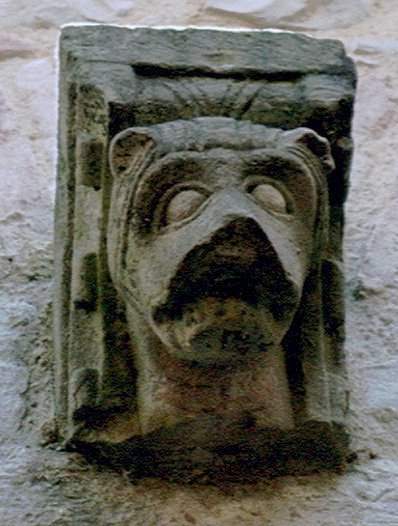 |
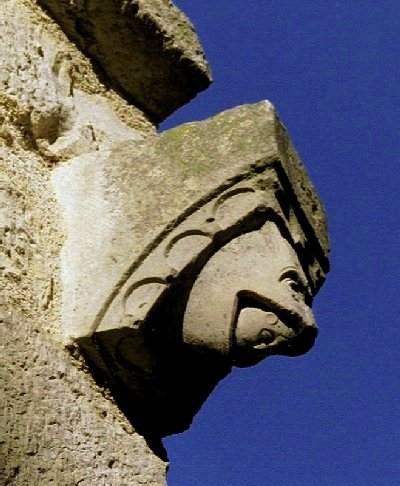 |
A corbel at the top end of the rue Droite.

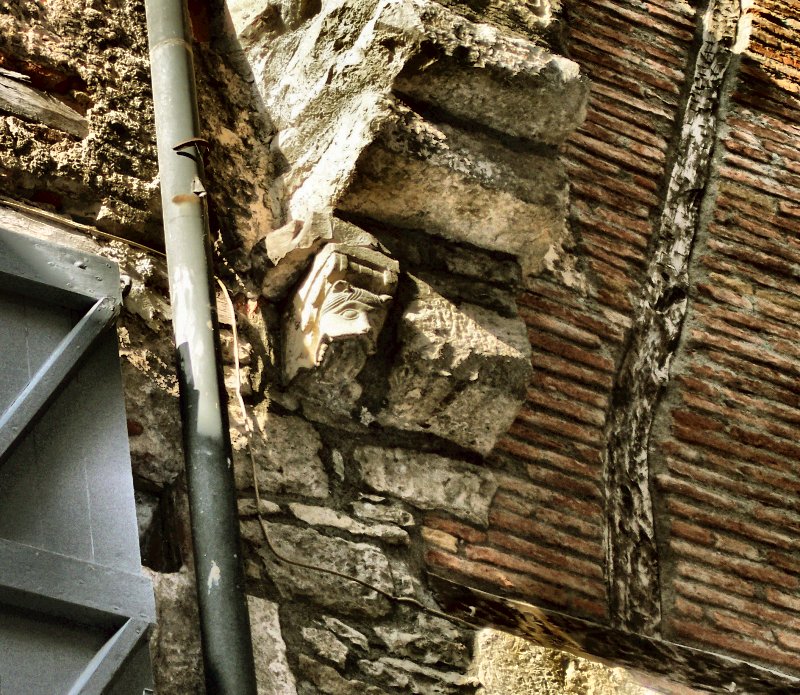
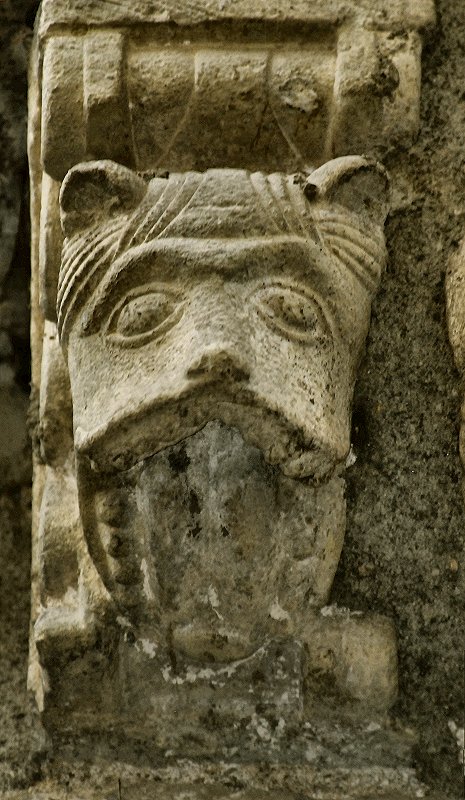
|
This very well-preserved Romanesque corbel at the bottom of the rue Droite is one of a handful now on the outside walls of houses in the mediæval town. This moustacheless male is a Blemya who has no head and whose face is on his torso - hence the arms seeming to issue from his head, in the same fashion as a beard-puller corbel on San Pere de Galligans in Girona. He seems to be gripping a reliquary (?) A similar bearded man, on a culot (corbel supporting a rib) at Tollevast in Northern Normandy has a similar item beneath him. Note the drilled eyes on this corbel, which are a late 12th-century feature, and the rat-ears. The 'nail-head' decoration around the figure echoes the teeth in the Jaws of Hell - much represented in Romanesque sculpture - and especially those devouring the female exhibitionist illustrated below.
|
The house in the rue Droite (Carrièra Drecha) into which the above corbel is inserted.
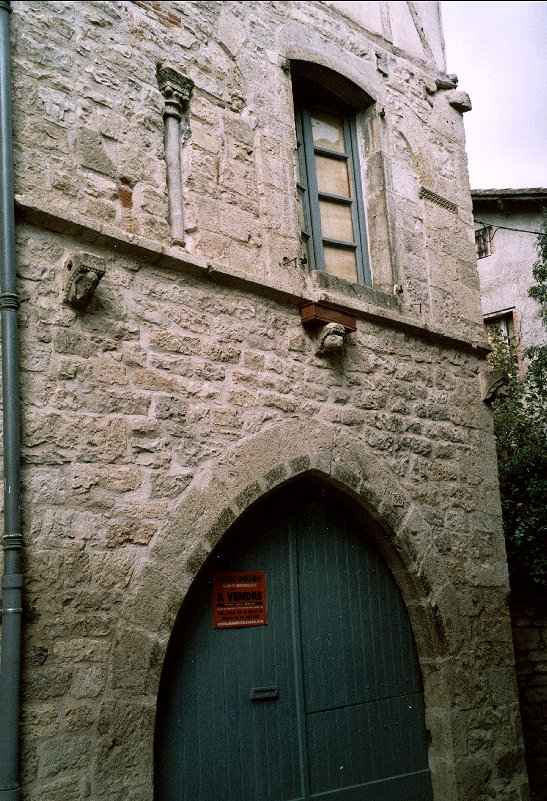
Close-up of another
corbel on the house shown above supporting a window-box.
It is a more fluid (but more eroded) example of the lioness-with-cub-in-its-jaws
which may represent Mother Church.
_____________________________________
12th century female exhibitionist mounted upside-down on a 17th century house.
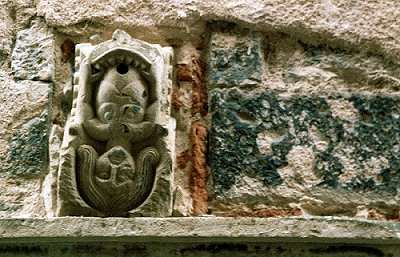
In remarkably
good condition, like the other corbels from the former abbey's collegiate church,
this superb carving depicts a female being swallowed by the jaws of Hell
as represented by a fine, toothy monster.
The Jaws of Hell are yet another Christian
borrowing from Classical mythology, such as Virgil's "Jaws of Tænarus",
the "High Portals of Dis" which are echoed - and challenged - by the
high portals of salvation
which are the churches of stone.
|
It is one of the finest of all female exhibitionist carvings. Stated on a tourist-map
of the town to be a depiction of St
Margaret of Antioch The few extant sculptures
of St Margaret are late-mediæval and depict her clothed. The photo below shows the corbel the right way up.
The large size and circularity of the vulva can be compared with
that of a mermaid at Zamora, click here to see the street where this is situated Compare the Saint-Antonin corbel also with one at Montmajour (Arles).
|
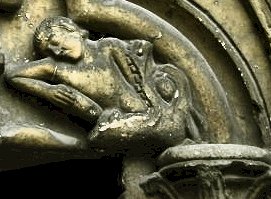
Compare with this detail of a tympanum in the Moselle.
text by Anthony Weir, Dissident Editions, www.irishmegaliths.org, www.irishmegaliths.org.uk, and author of IMAGES OF LUST